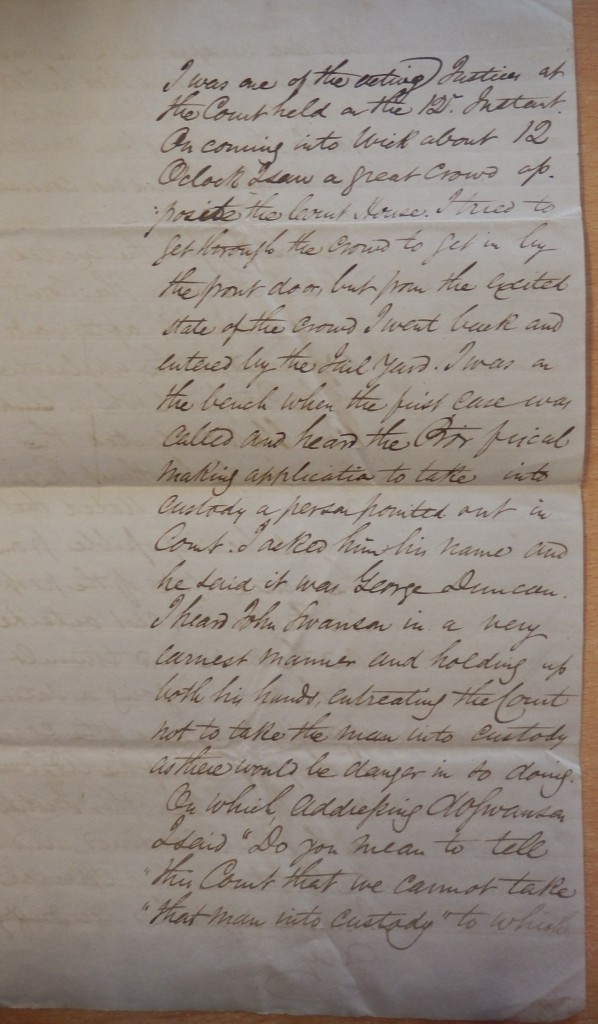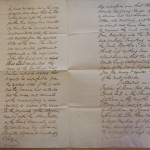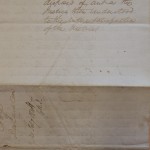
On the morning of 12 February 1844 some 600 people from Latheron marched on Wick, bearing banners and carrying sticks and umbrellas. They paraded through the town before gathering at the Court House on Bridge Street, where the trial of John Swanson and others was taking place for non-payment of Road Money (the tax for maintaining the county’s roads). There they were joined by hundreds of people from the town until some 1,800 people were jostling outside the court.
This seems to have been something of a test case, for Swanson was refusing to pay as a matter of principle, and the slogans on the banners proclaimed “The Constitution and Reform”. One man told a reporter from the John O’Groat Journal, “We are all true Highlanders, and we will turn their boots into shoes before night.” Another said, “The man that comes up to collect Road Money, had better bring his coffin along with him”.
The crowd tried to enter the court by the front door, and when that was barred by 200 special constables they tried to break in at the back. A blow aimed at the Procurator Fiscal missed him but struck another court official. John Swanson went out to remonstrate, saying “If there is a breach of the peace your case is completely done for”, and persuaded the crowd to wait in the street, despite their grievances (“But they struck us first”, “I was struck on the head, let me get a lick at the scoundrel”, etc.).
Inside the court, the Procurator Fiscal demanded the arrest of one of the alleged ringleaders, George Duncan of Auchnacraig. But John Swanson begged him not to proceed, arguing that given the mood of the crowd it would not be safe. At that, the court was adjourned on the grounds that it couldn’t carry out its lawful duties in the face of such intimidation.
We first learned of this extraordinary episode when we came across a deposition by Robert Innes among the Thrumster Estate papers. Robert Innes was one of the justices on the bench that day, and this is his first-hand account of the disturbance:
“On coming into Wick about 12 o’clock I saw a great crowd opposite the Court House. I tried to get in by the front door, but from the excited state of the crowd I went back and entered by the Jail Yard.” When the Procurator Fiscal called for George Duncan’s arrest, “I heard John Swanson in a very earnest manner and holding up both his hands entreating the Court not to take the man into custody as there would be danger in so doing.
“On which, addressing [John] Swanson I said, “Do you mean to tell this Court that we cannot take that man into custody?”, to which he replied that he had nothing to do with the people … but he did not think it advisable to take the man into custody from the excited state of the town.” The Court was then adjourned on the application of the Procurator Fiscal, who stated that “it would be impossible from the excited state of the people and the previous riot outside and the noise and tumult at the moment going on satisfactorily to dispose of the cases.”
 Robert Innes added: “My impression was that there would be great danger of a serious riot had Duncan been taken into custody, and that we should not have been able to prevent the mob outside from breaking into the Court and perhaps breaking up the Jails.”
Robert Innes added: “My impression was that there would be great danger of a serious riot had Duncan been taken into custody, and that we should not have been able to prevent the mob outside from breaking into the Court and perhaps breaking up the Jails.”
[Taken from John O’Groat Journal 16 February 1844, and Thrumster Estate Papers, P588]
